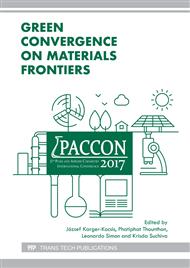[1]
C. Federici, P. Mufano, M.S. Storace, Ancient Paper and Its NMR Characterisation. Sci. Tech. Cult. Herit. 5 (1996) 37–47.
Google Scholar
[2]
L. Laguardia, E. Vassallo, F. Cappitelli, E. Mesto, A. Cremona, C. Sorlini, G. Bonizzoni, Investigation of the effects of plasma treatments on biodeteriorated ancient paper, Appl. Surf. Sci. 252 (2005) 1159–1166.
DOI: 10.1016/j.apsusc.2005.02.045
Google Scholar
[3]
E. Franceschi, Thermoanalytical methods : a valuable tool for art and archaeology, J. Therm. Anal. Calorim. 104 (2011) 527–539.
DOI: 10.1007/s10973-011-1343-x
Google Scholar
[4]
M. Manso, S. Pessanha, M.L. Carvalho, Artificial aging processes in modern papers: X-ray spectrometry studies, Spectrochim. Acta Part B. 61 (2006) 922–928.
DOI: 10.1016/j.sab.2006.07.002
Google Scholar
[5]
F. Pinzari, M. Zotti, A. De Mico, P. Calvini, Biodegradation of inorganic components in paper documents: formation of calcium oxalate crystals as a consequence of Aspergillus terreus Thom growth. Int. Biodeterior. Biodegrad. 64 (2010) 499–505.
DOI: 10.1016/j.ibiod.2010.06.001
Google Scholar
[6]
L. Hajji, A. Boukir, J. Assouik, H. Lakhiari, A. Kerbal, P. Doumenq, G. Mille, M. L. De Carvalho, Conservation of Moroccan manuscript papers aged 150, 200 and 800 years. Analysis by infrared spectroscopy (ATR-FTIR), X-ray diffraction (XRD), and scanning electron microscopy energy dispersive spectrometry (SEM–EDS), Spectrochim. Acta Part A. 136 (2015).
DOI: 10.1016/j.saa.2014.09.127
Google Scholar
[7]
G. Adami, A. Gorassini, E. Prenesti, M. Crosera, E. Baracchini, A. Giacomello, Micro-XRF and FT-IR/ATR analyses of an optically degraded ancient document of the Trieste (Italy) cadastral system (1893): A novel and surprising iron gall ink protective action, Microchem. J. 124 (2016).
DOI: 10.1016/j.microc.2015.07.020
Google Scholar
[8]
M. Manso, S. Pessanha, M.L. Carvalho, Artificial aging processes in modern papers: X-ray spectrometry studies, Spectrochimica Acta Part B. 61 (2006) 922–928.
DOI: 10.1016/j.sab.2006.07.002
Google Scholar
[9]
J. Rueangyodjantana and R. Buntem, Cellulose extraction and paper making from Khoi bark, Veridian E-Journal Science and Technology Silpakorn University. 4(2017) 50-59.
Google Scholar
[10]
D. Ciolacu, J. Kovac, V. Kokol, The effect of the cellulose-binding domain from Clostridium cellulovorans on the supramolecular structure of cellulose fibers, Carbohydr. Res. 345 (2010) 621–630.
DOI: 10.1016/j.carres.2009.12.023
Google Scholar
[11]
K. Castro, E. Princi,N. Proietti, M. Manso, D. Capitani, S. Vicini, J.M. Madariaga, M.L. De Carvalho, Assessment of theweathering effects on cellulose basedmaterials through a multianalytical approach, Nucl. Instrum. Methods B. 269 (2011).
DOI: 10.1016/j.nimb.2011.03.027
Google Scholar
[12]
P. Calvini, A. Gorassini, G. Luciano, E. Franceschi, FTIR and WAXS analysis of periodate oxycellulose: evidence for a cluster mechanism of oxidation, Vib. Spectrosc. 40 (2006) 177–183.
DOI: 10.1016/j.vibspec.2005.08.004
Google Scholar
[13]
D.N. -S. Hon, N. Shiraishi, Wood and Cellulosic Chemistry, in: F. Horii, Structure of Cellulose: Recent Developments in Its Characterization, 2nd ed. Marcel Dekker, New York 2001, p.83–108.
Google Scholar
[14]
S. Xiao, R. Gao, Y. Lu, J. Li, Q. Sun, Fabrication and characterization of nanofibrillated cellulose and its aerogels from natural pine needles, Carbohydr. Polym. 119 (2015) 202–209.
DOI: 10.1016/j.carbpol.2014.11.041
Google Scholar
[15]
S.M. Santos, J.M. Carbajo, E. Quintana, D. Ibarra, N. Gomez, M. Ladero, M.E. Eugenio, J.C. Villar, Characterization of purified bacterial cellulose focused on its use on paper restoration, Carbohydr. Polym. 116 (2015) 173–181.
DOI: 10.1016/j.carbpol.2014.03.064
Google Scholar
[16]
A. Xu, L. Cao, B. Wang, Facile cellulose dissolution without heating in [C4mim][CH3COO]/DMF solvent, Carbohydr. Polym. 125 (2015) 249–254.
DOI: 10.1016/j.carbpol.2015.07.085
Google Scholar
[17]
M. Ni and B. D. Ratner, Differentiation of Calcium Carbonate Polymorphs by Surface Analysis Techniques-An XPS and TOF-SIMS study, Surf. Interface Anal. 40 (2008) 1356–1361.
DOI: 10.1002/sia.2904
Google Scholar
[18]
N. Asikin-Mijan, H.V. Leea, Y.H. Taufiq-Yap, J.C. Juana, N.A. Rahman, Pyrolytic-deoxygenation of triglyceride via natural waste shell derived Ca(OH)2 nanocatalyst, J. Anal. Appl. Pyrol. 117 (2016) 46–55.
DOI: 10.1016/j.jaap.2015.12.017
Google Scholar


